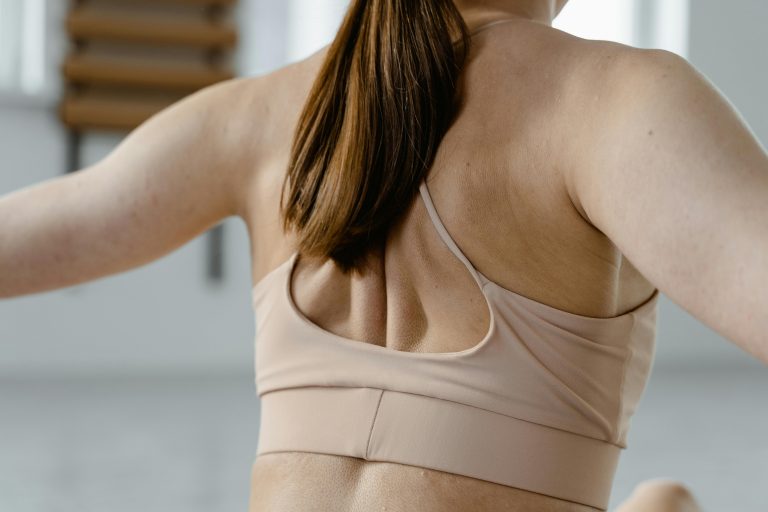What Causes Back Fat? Understanding the Factors Behind This Common Issue

Back fat is a common concern for many people, and it can affect individuals of all body types. While some people may find it particularly troublesome, it’s essential to understand that back fat is completely normal. However, the good news is that with the right lifestyle changes, you can reduce and manage back fat more effectively. In this article, we’ll take a closer look at what causes back fat and provide you with actionable tips on how to get rid of back fat.
1. Genetics and Hormones: The Role of Your DNA and Body Chemistry

Your genetics play a significant role in determining where your body stores fat. Some people are genetically predisposed to accumulate more fat in their upper back, lower back, or other specific areas. For example, individuals with a family history of back fat may find it harder to manage fat in this region compared to others.
Hormones also heavily influence fat distribution in your body. For women, the presence of estrogen during puberty and menopause can lead to the storage of fat in the hips, thighs, and back. As a result, back fat tends to appear more prominently during certain phases of life, such as pregnancy or menopause. In men, testosterone plays a key role in fat distribution, and as testosterone levels decrease with age, men may notice an increase in fat around the belly, back, and chest areas.
As people age, their hormones naturally shift, leading to a redistribution of fat in the body. For women, this often results in more fat accumulating around the back after menopause due to a decrease in estrogen. Similarly, for men, the drop in testosterone can also lead to an increase in back fat.
Tip: While genetics and hormones are beyond your control, understanding how they impact your body allows you to make better decisions regarding diet, exercise, and overall lifestyle. Staying active, eating a balanced diet, and managing stress can help mitigate these effects.
2. Poor Posture and Back Fat: How Slouching Affects Fat Storage
You may be surprised to learn that poor posture can make back fat appear more prominent. When you slouch or round your shoulders, your muscles are not properly engaged. As a result, fat around your back can be more noticeable, and the natural curves of your body may be hidden. When the muscles in your back and core aren’t activated through good posture, your body may store more fat in these areas, especially over time.
Maintaining good posture is not only important for preventing back pain but also for reducing the appearance of back fat. When you stand up straight, with your shoulders back and chest lifted, the muscles in your back and core engage, which can help reduce the visibility of back fat.
Tip: Try to practice good posture throughout the day. Stand with your feet shoulder-width apart, shoulders back, and chin lifted. Avoid slouching while sitting, and make an effort to straighten your back whenever you are standing or walking.
3. Unhealthy Diet: The Link Between Nutrition and Fat Accumulation

Your diet plays a major role in determining how much fat you store, including in your back area. A poor diet high in processed foods, refined carbohydrates, sugar, and unhealthy fats can lead to weight gain, including the accumulation of back fat. Eating calorie-dense foods, such as fast food, sugary snacks, and fried items, can cause your body to store fat, which often settles in areas like your back, abdomen, and thighs.
Conversely, a well-balanced diet rich in whole foods such as fruits, vegetables, lean proteins, and healthy fats can help regulate your weight and reduce back fat. Foods like salmon, avocado, nuts, and leafy greens are known to help promote fat loss while providing essential nutrients.
Tip: Focus on eating nutrient-dense foods and avoid highly processed, sugary, and high-calorie items. Drinking plenty of water and limiting alcohol consumption can also help control your calorie intake and prevent fat accumulation.
4. Lack of Physical Activity: Why Exercise Is Key to Reducing Back Fat
A sedentary lifestyle is another significant cause of back fat. When you don’t get enough physical activity, your metabolism slows down, and your body has fewer opportunities to burn the calories you consume. As a result, fat is stored in areas like the back, arms, and belly. Regular exercise is crucial for fat loss, especially for reducing back fat. Cardio exercises, such as walking, running, cycling, and swimming, can help burn calories and reduce overall body fat.
Strength training is equally important, as it helps build lean muscle mass, which in turn boosts your metabolism and makes it easier to burn fat. Additionally, strength training helps tone the muscles in your back, improving the overall appearance of the area.
Tip: Aim to engage in a combination of cardio and strength training exercises at least 3-5 times a week. Activities like planks, rows, and lat pulldowns specifically target the muscles in your back, making them an excellent addition to your routine.
5. Stress and Cortisol: The Hidden Connection to Back Fat
Chronic stress is a major factor that can lead to the accumulation of back fat. When you are stressed, your body releases a hormone called cortisol. Cortisol is often referred to as the “stress hormone” because it plays a key role in your body’s stress response. However, when cortisol levels remain elevated due to prolonged stress, it can encourage the storage of fat, particularly in the abdominal and back areas.
Furthermore, stress can lead to unhealthy eating habits, such as emotional eating or cravings for high-sugar, high-fat foods. This combination of factors can contribute to back fat.
Tip: Finding ways to manage stress is essential for preventing fat accumulation. Consider practicing stress-reducing activities such as yoga, meditation, journaling, or simply taking time for yourself each day to unwind.
6. Age-Related Changes: The Impact of Aging on Fat Storage
As you age, your body experiences a series of natural changes that can impact how fat is stored, particularly in the back. One of the key changes is a gradual decrease in muscle mass, which tends to start around the age of 30. Muscle loss is a part of the aging process, and it can lead to a slower metabolism. A slower metabolism means that your body burns fewer calories at rest, making it easier to gain fat, especially if you’re not engaging in regular physical activity. This loss of muscle mass, paired with a decrease in physical activity, can contribute to fat storage in various areas of the body, including the back.
Hormonal changes also play a significant role in the redistribution of body fat as you age. For women, a decline in estrogen levels during menopause can lead to fat accumulating around the abdomen and back. In men, a decrease in testosterone levels can result in an increase in fat storage in the same areas. These hormonal shifts, combined with changes in metabolism and muscle mass, can cause fat to accumulate in places that were once less prone to storing fat, such as the back. Additionally, a less active lifestyle, which often comes with aging, can further exacerbate this fat buildup, making it more difficult to target and reduce back fat.
Tip: Strength training is especially important as you age to preserve muscle mass and maintain a higher metabolic rate. Stay active and make regular physical activity a priority in your routine.
7. Sleep Deprivation and Fat Storage: How Poor Sleep Affects Your Body
Sleep plays an essential role in maintaining a healthy weight. When you don’t get enough sleep, your body’s hormonal balance can be disrupted, leading to increased hunger and cravings for unhealthy foods. Furthermore, lack of sleep increases cortisol levels, which can promote fat storage, particularly around the back and abdominal areas.
Sleep deprivation can also make it harder to stay consistent with your exercise routine, which further exacerbates back fat accumulation.
Tip: Aim for 7-9 hours of quality sleep each night. Creating a bedtime routine, limiting screen time before bed, and keeping your sleeping environment cool and comfortable can help improve sleep quality.
8. Genetic Predisposition to Fat Storage: Is Back Fat in Your Genes?
While genetics are not the sole determining factor in fat storage, they do play a significant role. If your family members tend to store fat in their back, there’s a good chance you may experience the same pattern. However, this doesn’t mean that you can’t take steps to minimize back fat.
Tip: While genetics may predispose you to store fat in certain areas, lifestyle factors like diet, exercise, and stress management can make a big difference in how much back fat you carry.
How to Get Rid of Back Fat
Reducing back fat involves a combination of healthy eating, regular exercise, and lifestyle changes. While spot reduction isn’t possible, focusing on overall fat loss and toning your back muscles can help you achieve a more defined and toned appearance. Here’s a comprehensive guide to getting rid of back fat.
1. Adopt a Balanced Diet
The first step to reducing back fat is to make healthier food choices. Focus on a diet rich in whole foods, such as lean proteins, fruits, vegetables, and whole grains, while avoiding processed and sugary foods.
- Lean Proteins: Incorporate lean protein sources such as chicken, turkey, tofu, legumes, and fish like salmon. Protein helps build and repair muscles, including those in your back, while keeping you feeling full longer.
- Fruits and Vegetables: These foods are low in calories and high in fiber, vitamins, and antioxidants. They help you stay full and reduce inflammation that can lead to weight gain.
- Whole Grains: Whole grains like quinoa, brown rice, and oats provide fiber, which helps regulate digestion and prevent overeating.
- Healthy Fats: Include healthy fats from sources like avocados, nuts, and olive oil. These fats help reduce inflammation and support fat loss.
What to Avoid: Cut out processed foods, sugary snacks, and refined carbohydrates, as they contribute to fat accumulation, including back fat.
2. Engage in Regular Exercise
Exercise is key to reducing back fat. While you can’t target fat loss from just one area, regular physical activity helps you burn calories, boost metabolism, and tone muscles.
- Cardio Exercises: Cardio helps you burn calories and promote fat loss. Try running, cycling, swimming, or even jump rope to get your heart pumping. Aim for 150 minutes of moderate-intensity cardio each week.
- Strength Training: Strength training builds muscle and boosts metabolism, helping you burn fat more effectively. Focus on exercises that target the back muscles, such as rows, lat pulldowns, and deadlifts. These moves help tone your upper and lower back.
Tip: Combining both cardio and strength training is ideal for overall fat loss and back toning.
3. Make Lifestyle Changes
Lifestyle habits also play a big role in reducing back fat. Here are some tips that can support your fat loss goals:
- Manage Stress: Chronic stress increases cortisol levels, a hormone that promotes fat storage. Practice stress-reducing techniques like meditation, deep breathing, or yoga to lower cortisol and prevent fat accumulation in your back.
- Prioritize Sleep: Poor sleep can disrupt metabolism and lead to overeating. Aim for 7–9 hours of sleep each night to support fat loss and muscle recovery.
- Stay Hydrated: Drinking enough water helps with digestion, metabolism, and overall fat loss. Aim to drink at least 8 cups of water per day.
4. Be Patient and Stay Consistent
Getting rid of back fat takes time and consistent effort. Fat loss is a gradual process, and it’s essential to stay committed to your healthy eating, exercise routine, and lifestyle changes. Don’t expect overnight results, but with patience, you’ll start seeing improvements.
Tip: Celebrate small milestones, such as feeling stronger or seeing progress in your workouts. Consistency is key to long-term success.
Conclusion
Back fat can be a frustrating issue, but understanding the causes behind it gives you the tools to address and manage it effectively. Whether it’s due to genetics, poor posture, stress, or an unhealthy diet, there are several ways to reduce back fat and improve the overall appearance of your back. By making small changes in your daily habits, such as improving your posture, eating a balanced diet, exercising regularly, and managing stress, you can reduce back fat and feel more confident in your body. Remember, consistency is key when it comes to eliminating back fat, so stay dedicated to your goals and make sustainable lifestyle changes for long-term results.

